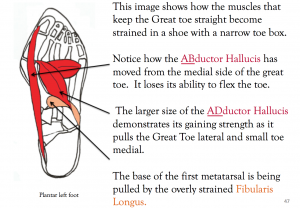The bunion.
Is it a growth?–Is it lump?–Did I inherit this?–What is thing on the side of my big toe???
It is the belief of many that bunions are caused by a hereditary gene passed to them from a parent or grandparent because they had one too. This however, is more folklore than actual. There are many potential causes of the development of a bunion but today let’s talk about the most likely cause: The toe-box design of Shoes. The truth is our parents and even grandparents wore shoes that were narrow and tapered, just like the shoes that are made today which means–shoes caused their bunions too.
Lets set the record straight about the bunion:
A bunion, hallux valgus, is a dislocation of the first metatarsal and the great toe. In the following images I have drawn the muscles that stabilize the great toe. The first image of muscles in red show their normal connections to the inside of the great toe, and the double muscles that connect to the opposite side of the great toe. The next image shows what happens to these muscles when put into a tapered toe-box shoe. The muscle colored in yellow is the fibularis longus. This long foot muscle shares a tendon connection with the oblique head of the adductor hallucis muscle. If shoes are too small or too narrow it will cause increasing tension in the fibularis longus muscle which will then excessively pull at its attachment site at the base of the first metatarsal bone and, because this muscle shares a tendon connection with the adductor hallucis, it pulls this muscle with it–and soon the bones of the great toe dislocate.




The heart can be affected too
Feet are so resilient and adaptable to being folded in shoes that this type of dislocation may take up to 15 to 20 years to develop. When, or if it does, the damage may be difficult to correct because the ligaments beneath these muscles that hold the bones together become overly stretched and lose their elasticity and ability to spring the big toe back into place. However do not despair– bunions are correctable without surgery. Yes–indeed. Surgery would alter the integrity of the foot and therefore would not be my preference. Although I am thankful for skillful surgeons, less invasive alternatives to cutting the feet should be explored first.
One of these alternatives is Reflexology which naturally releases stress in the body and in the feet. To help release tension causing bunion, Structural Reflexology® also integrates massage and gentle traction techniques specifically to relax the fibularis longus, as well as the abductor and adductor hallucis muscles. Subsequently, the relief of strain gives the great toe room to move and relocate into a healthier position. Keep in mind that once correction is made the appearance of the dislocation may not dramatically change, nevertheless, you will gain comfort and function–which should be your goal.
In order to keep the bones of the feet stable, you must wear shoes that fit your toe-box.
Try this self-care exercise to help align the great toe with the first metatarsal:
With your bare feet on the floor, keep your big toes together and place a thick rubber band around your right and left big toe (the one that holds broccoli is usually ideal). With your heels together try to separate your big toes. The rubber band should be tight enough to resist this action but allow some movement that will draw your big toes inward. Repeat 10 times a day in the am and pm–lesser reps if your toes get too tired. Build up up your repetitions by 2 each week.
It is very important to keep the great toes as functional as possible because if not, eventually the feet will lose their ability to hold weight, leaving the body vulnerable to collapse.
Be kind to your feet and they will reward you for years to come!
Archives
- October 2024
- December 2023
- October 2023
- March 2022
- July 2021
- August 2020
- May 2020
- April 2020
- February 2020
- January 2020
- December 2019
- November 2019
- October 2019
- August 2019
- June 2019
- May 2019
- April 2019
- January 2019
- December 2018
- October 2018
- September 2018
- July 2018
- June 2018
- April 2018
- February 2018
- December 2017
- November 2017
- October 2017
- September 2017
- August 2017
- July 2017
- June 2017
- May 2017
- April 2017
- February 2017


